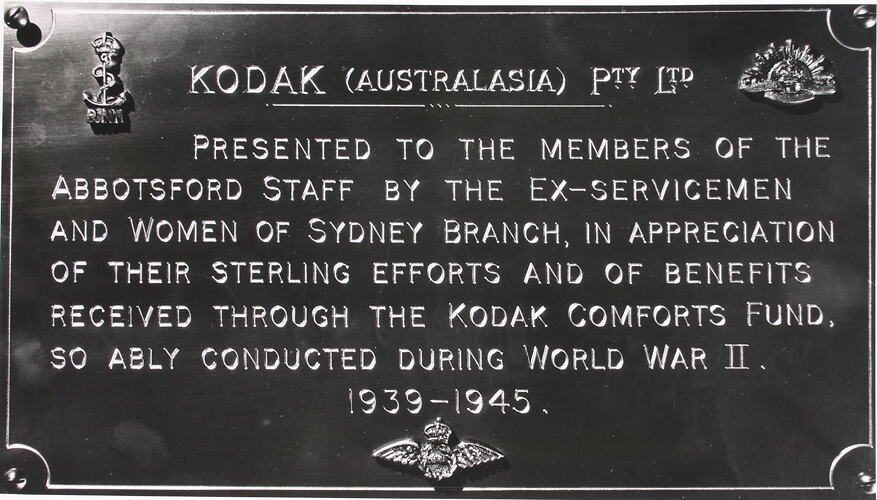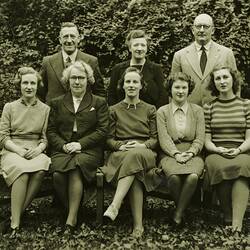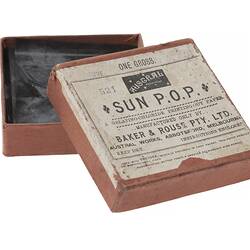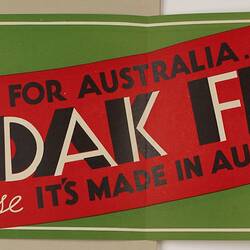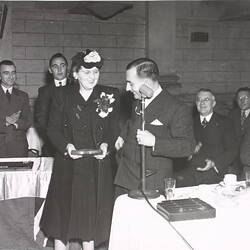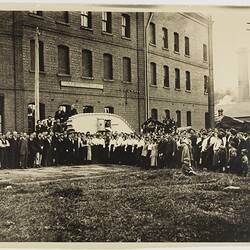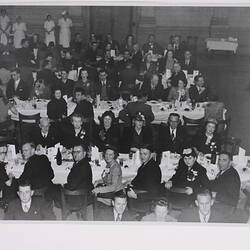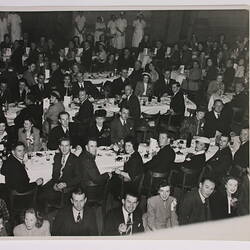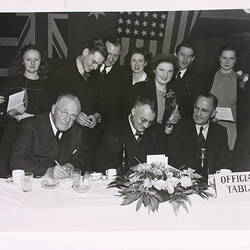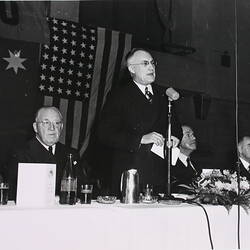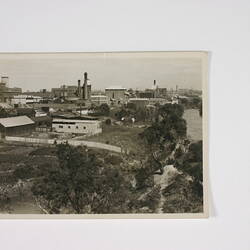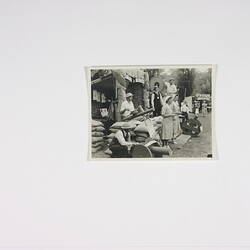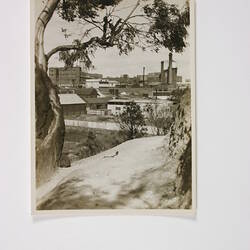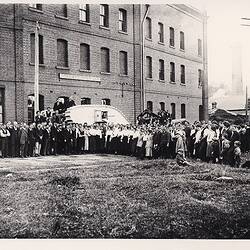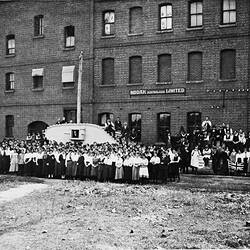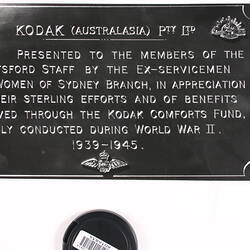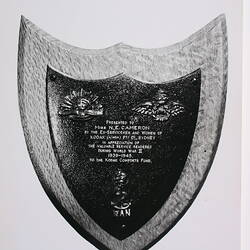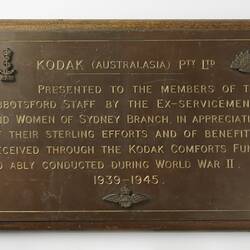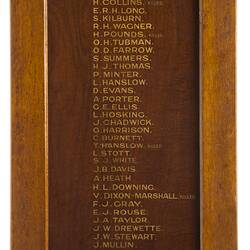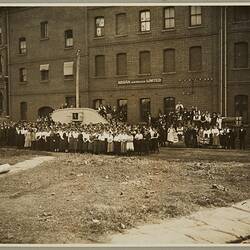Kodak Wartime Comforts Fund: Wartime Volunteering, Fundraising and the Home Front
Kodak Australasia Pty Ltd, established in Melbourne in 1908, fostered a responsible and modern work culture. The company employed generations of Melbournians, many from the same family, who typically spent their entire working life with Kodak. The company was one of the first to establish a Provident Fund - whereby employees received, for a nominal weekly payment, a pension following their retirement - as well as a staff canteen, company medical facilities and care, and rental homes for staff adjacent to the Abbotsford factory which were leased to employees and their families at reasonable rates.
Kodak also has a long history of supporting charitable causes during both war and peacetime. Thomas Baker, who established Baker & Rouse, and was later one of Kodak Australasia's founders, was a successful businessman and philanthropist. Not content to dedicate his life to photography, Baker was also involved in munitions manufacture during World War I, and invested large sums of money prospecting for oil in Australia and New Zealand. He also generously donated considerable funds towards medical research in Melbourne. In keeping with his early training as a chemist, Baker, along with his wife Alice and sister-in-law Eleanor Shaw, donated funds in 1913 for cancer research and in 1922 financed a biochemistry department at the Alfred Hospital named the Baker Institute. Through their wills, the three benefactors also established a trust for the ongoing funding of medical research at the Baker Institute. The Bakers also gave funds to other charities, including the Red Cross and the Limbless Soldiers. Thomas Baker's generosity continued after his death; he left an estate valued at £261,000 and after providing for his wife and sister-in-law, bequests of shares or money were made to his relatives and legacies to many employees. His generosity towards his 'Kodak family' was considerable and 'employees of eight years or more received a legacy based on years of service and elderly women employees were given annuities' (Mortley, 1983, p. 33). A trust fund was then established with the remaining monies, the income of which was used for charitable purposes.
Kodak Australasia Pty Ltd is regularly mentioned in historic newspaper records as providing donations to patriotic and charitable funds and was also involved in co-ordinating various volunteer and fundraising efforts within the community. The Abbotsford War Bonds Appeal was held at the Kodak Factory in Abbotsford in 1917, and images from the Kodak Heritage Collection (MM 98574 and MM 98572) depict Kodak employees assembled around a tank for a group portrait at the event. There are also numerous newspaper records documenting Kodak's generous fiscal contributions to the war effort during the two World Wars.
However, Kodak's generosity and fundraising efforts extend far beyond contributing to the support of the war effort itself. During the World War II Baker & Rouse Kodak helped thousands of friends and families stay in touch, playing a pivotal role in the processing of microfilmed Australian, British Airgraph and American V-mail letters. In 1928 Recordak, a subsidiary of Eastman Kodak developed a system for photographing objects and reducing the negative. While the idea to use the technology for postal services had been suggested and dismissed in the past due to privacy concerns Lt. Col. John Moore-Brabazon, a British pilot who served during the First World War and as Minster for Transport during the World War II, suggested that personal letters from the troops could be photographed onto microfilm to be enlarged and reprinted at their destination in order to save weight and space on aircraft travelling between the United Kingdom and the Middle East. The process was a resounding success and quickly spread to other areas worldwide, including Australia. There is a series of photographs in the Kodak Heritage Collection documenting employees at the Kodak factory in Abbotsford enlarging, printing and cutting Airgraph letters (MM 96604, MM 96606, MM 96605 and MM 96607), as well as an Airgraph letter with envelope and microfilm attached from Private Jimmy Jones addressed to the chairman of the Australian Kodak Comforts Fund (HT 21480).
Kodak (Australasia) Pty Ltd also organised and funded exhibitions of war photographs, during and after both World Wars in order to raise money for charity. On 4 April 1919 the Sydney Morning Herald wrote that 'a cheque for the sum of £200 had been handed to the Red Cross by Kodak (Australasia) Ltd as a result of the exhibition of war photographs by Captain Frank Hurley, recently concluded at the Kodak Salon. The charges for admission and the sale of catalogues amounted to £179/2/6 and a further amount of £20/17/6 was given by Kodak making a total of £200.' Similarly on 24 August 1940 The Argus newspaper notes that 'the war photograph exhibition at Kodak House. has been visited by hundreds of persons who have been keenly interested in this pictorial record of contemporary history' and that 'the proceeds are to be given to the [Australian] Comforts Fund.'
Kodak was dedicated to supporting Australian servicemen. During World War I, an article in the Argus newspaper from 21 July 1916 notes that 'the sum of £100 had been granted by the directors to the purchase of wool and this the girls of the firm's employ had made into socks for soldiers and thousands of articles had been dispatched'. The article goes on to state that 20 returning soldiers had been given employment at Kodak and that 'when vacancies occurred, preference was given to returned men. This is a trend which continued during and after both World Wars, with the company taking great care to find returning employees positions which were consistent with their former responsibilities and skills.
In 1940 a dinner was held to farewell three members of the Melbourne based Kodak staff who were leaving for active service. Guests at the dinner were entertained by 69 members of staff, who were returned soldiers, at a smoke social held in the dining room of the Abbotsford factory. The dining room was transformed into a 'realistic reproduction of a wartime scene complete with trenches, duckboards and dugouts' and the evening featured a 'miniature air raid, with searchlights picking out an aeroplane circling around the room, fireworks to represent anti-aircraft fire and the departure of a troopship bedecked with streamers' (The Argus, 10 Feb 1940).
In 1941 Kodak Australasia Pty Ltd established the Kodak Comforts Fund. Under the direction of the fund's chairman Miss Nellie Elma (Nell) Cameron, Kodak employees volunteered, donated and raised funds in order to support and provide comforts to employees enlisted in His Majesty's Armed Forces for the duration of the World War II. According to an unpublished company manuscript titled The History of Kodak in Australia, members of the fund 'kept their absent Kodak workmates in touch with the activities at home by writing regular letters, sending service bulletins containing news of company doings, parcels of warm clothing including hand knitted socks, balaclavas and gloves and money orders' (Mortley, 1983, p. 71). Images of Kodak Comforts Fund events show staff dressed as nurses and soldiers as part of a war re-enactment event with sandbags, replica machine guns and cannons (MM 96630) while another photograph documents six female employees wearing floral leis and dressed in Hawaiian outfits (MM 96629). While there is little documentation of these Kodak Comforts Funds events, it can be assumed that employees were organising these events and activities in order to raise money to contribute to the fund's efforts. Kodak staff also organised their own personal fundraising events, such as Gordon Clark of the Cine Department at Abbotsford, who held an exhibition of his tropical fish in March 1944, raising 23 pounds and 17 shillings for the Kodak Comfort Fund.
Under the National Security (Patriotic Funds) Regulation the fund was required to keep a progressive statement of receipts and expenditure. This documentation shows that when the Kodak Comforts Fund was closed on 30 June 1946 it had raised more than £7,275. Of that money more than £6,486 had been used primarily to provide comforts to Kodak employees and their dependents. After the war ended the surplus monies from the fund, which amounted to just over £789, were used to purchase 'a fully paid up endowment policy in favour of each child of the Kodak men who made the supreme sacrifice' (Nellie Elma Cameron, 1946) following a vote by Kodak service personnel. Three Kodak employees died while on active service: Victor Joseph Wakeham, who had worked in the dark room at Kodak before the war, was killed in action in Libya on 31 October 1943; Leslie Malcolm Macfarlane, previously a truck driver for Kodak, was killed in New Guinea on 23 August 1943; and William John Brown, a Sapper (field engineer) during the war, who sadly died of illness in Wagga Wagga on 12 May 1944. The Kodak Heritage Collection contains correspondence relating to the Kodak Comforts Fund and the endowments provided for the children of the three Kodak employees killed during the World War II and further information is preserved in the Australian Archives.
After the conclusion of the war in 1945, the efforts of not only the returning servicemen but also the 'sterling efforts' of members of the Kodak Comforts Fund were recognised at a dinner held at the Sydney branch in either 1946 or 1947. A series of images from the Kodak Heritage Collection documents the evening's festivities (MM 96063, MM 96064, MM 96065, MM 96066 and MM 96067) and the presentation of a plaque to a woman (MM 96068). The collection also contains an image of a plaque presented to Miss Cameron, Chairman of the Kodak Comforts Fund, by the ex-servicemen and women of Kodak Australasia Sydney in honour of the valuable service rendered during World War II; however it is unclear whether the image from the returned serviceman dinner documents the moment she received it.
Kodak Australasia Pty Ltd's involvement in Australia's wartime efforts and history is both varied and considerable. The above information is by no means comprehensive and any stories from former Kodak employees relating to Kodak's contribution to Australia's war efforts, particularly regarding the Kodak Comforts Fund, will be warmly welcomed by the curators of the Museum Victoria's Kodak Heritage Collection.
References
'War Photographs for Comforts Fund' The Argus, Saturday 24 August 1940, p.5
'Kodak Australasia Ltd' The Argus, Friday 21 July 1916, p.4
'Realism in Send-Off' The Argus, Saturday 10 February 1940, p.2
'Captain Hurley's War Photographs' Sydney Morning Herald, Friday 4 April 1919, p. 8
Mortley (1983). The History of Kodak in Australia, Unpublished MSS
http://www.remuseum.org.uk/specialism/rem_spec_pcsww2.htm accessed 29 October
Miss. Nellie Elma Cameron, Chairman of the Kodak Comforts Fund, Personal Letter, 14 May 1946, Comforts Fund File, Kodak Heritage Collection
HT 48082 - Letter from Nell Cameron to Noel Swan, 11 March 1944
More Information
-
Keywords
war relief, World War II, World War I, Australians at war, Photography
-
Authors
-
Article types
